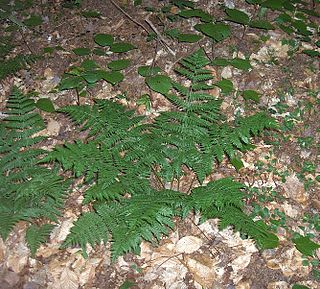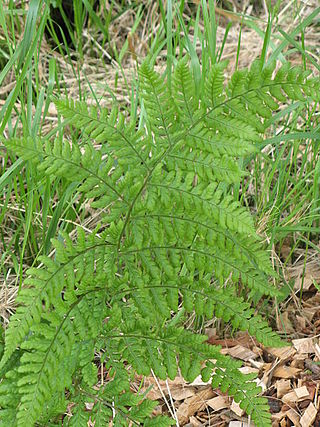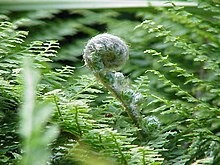
Geranium cinereum, the ashy cranesbill, is a species of flowering plant in the family Geraniaceae, native to the Pyrenees. Growing to 50 cm (20 in) tall and wide, it is a small, deciduous or semi-evergreen perennial usually grown for low ground cover, rockeries or underplanting larger subjects like roses. Leaves are deeply divided and grey-green – whence the Latin specific epithet cinereum "ash-grey". It flowers in summer, with striking black-eyed flowers with black stamens. The plant grows in full sunlight, and is hardy down to −15 °C (5 °F).

Euphorbia mellifera, the Canary spurge or honey spurge, is a species of flowering plant in the spurge family Euphorbiaceae, native to Madeira and the Canary Islands. It is an evergreen shrub or tree growing to 2.5 m (8.2 ft) tall and broad, with narrow leaves up to 20 cm (8 in) long. In spring it produces brown, honey-scented flowers.

Polystichum munitum, the western swordfern, is an evergreen perennial fern native to western North America, where it is one of the most abundant ferns in forested areas. It occurs along the Pacific coast from southeastern Alaska to southern California, and also inland east to southeastern British Columbia, northern Idaho and western Montana, with disjunctive populations in northern British Columbia, Canada; the Black Hills in South Dakota, United States; and Guadalupe Island off of Baja California, Mexico. Western swordfern is known to have locally naturalized in parts of Great Britain and Ireland.

Dryopteris filix-mas, the male fern, is a common fern of the temperate Northern Hemisphere, native to much of Europe, Asia, and North America. It favours damp shaded areas in the understory of woodlands, but also shady places on hedge-banks, rocks, and screes. Near the northern limit of its distribution it prefers sunny, well-drained sites. It is much less abundant in North America than in Europe.

Gymnocarpium dryopteris, the western oakfern, common oak fern, oak fern, or northern oak fern, is a deciduous fern of the family Cystopteridaceae. It is widespread across much of North America and Eurasia. It has been found in Canada, the United States, Greenland, China, Japan, Korea, Russia, and most of Europe. It is a seedless, vascular plant that reproduces via spores and have a life cycle with alternating, free-living sporophyte and gametophyte phases.

Osmunda regalis, or royal fern, is a species of deciduous fern, native to Europe, Africa and Asia, growing in woodland bogs and on the banks of streams. The species is sometimes known as flowering fern due to the appearance of its fertile fronds.

Athyrium filix-femina, the lady fern or common lady-fern, is a large, feathery species of fern native to temperate Asia, Europe, North Africa, Canada and the US. It is often abundant in damp, shady woodland environments and is often grown for decoration.

Polystichum aculeatum, the hard shield-fern, is an evergreen fern native to Europe. It is most abundant in upland regions of the British Isles and western France, where it benefits from the combination of mild winters and moist summers, but also occurs more locally across most of Europe except northern Scandinavia, northern Russia; in the Mediterranean region it is confined to high altitudes. It grows on steep slopes in woodlands. it is sometimes considered an indicator of the presence of ancient woodlands.

Dryopteris erythrosora, the autumn fern or Japanese shield fern, is a species of fern in the family Dryopteridaceae, native to east Asia from China and Japan south to the Philippines, growing in light woodland shade on low mountains or hills.

Dryopteris affinis, the scaly male fern or golden-scaled male fern, is a fern native to western and southern Europe and southwestern Asia. It is most abundant on moist soils in woodlands in areas with high humidity, such as the British Isles and western France. In the Mediterranean region and the Caucasus it is confined to high altitudes.

Athyrium niponicum, the Japanese painted fern, is a species of fern native to eastern Asia.

Polystichum acrostichoides, commonly denominated Christmas fern, is a perennial, evergreen fern native to eastern North America, from Nova Scotia west to Minnesota and south to Florida and eastern Texas. It is one of the most common ferns in eastern North America, being found in moist and shady habitats in woodlands, stream banks and rocky slopes. The common name derives from the evergreen fronds, which are often still green at Christmas.

Asplenium trichomanes, the maidenhair spleenwort, is a small fern in the spleenwort genus Asplenium. It is a widespread and common species, occurring almost worldwide in a variety of rocky habitats. It is a variable fern with several subspecies.

Dryopteris intermedia, the intermediate wood fern or evergreen wood fern, is a perennial, evergreen wood fern native to eastern North America. It is a diploid species, and is the parent of several species of hybrid origin, including Dryopteris carthusiana. Other common names for this species include intermediate shield fern, fancy wood fern, fancy fern, glandular wood fern, American shield fern and common wood fern.

Pellaea rotundifolia, the button fern, is a species of fern endemic to New Zealand, where it grows in scrub and forests. It is also a popular garden plant and house plant, tolerating low temperatures but not freezing.

Polystichum tsus-simense, commonly known as the Korean rock fern, is a perennial herbaceous plant native to East Asia. Its common name corresponds with its ability to grow in shady areas of rock walls. This fern species is a familiar ornamental plant grown in home gardens.

Dryopteris dilatata, the broad buckler-fern, is a robust species of deciduous or semievergreen fern in the family Dryopteridaceae, native to Europe, particularly western and central Europe. In southern Europe, it is mostly found in mountainous regions. It is also found between the Black Sea and the Caspian Sea. It grows to 90 cm (35 in) tall by 120 cm (47 in) wide, with dark green tripinnate fronds, the ribs covered in brown scales.

Polypodium cambricum, the southern polypody, limestone polypody, or Welsh polypody, is a species of fern in the family Polypodiaceae, native to southern and western Europe where it grows on shady rocks, near the coasts of the Mediterranean Basin and in the mountains of Atlantic Europe. It is a spreading, terrestrial, deciduous fern growing to 60 centimetres (24 in) tall, with pinnate fronds. The sori are yellow in winter.

Woodwardia radicans, the chain fern, European chain fern or rooting chainfern, is a species of fern in the family Blechnaceae, mainly found in Macaronesia and southwestern Europe, but is also found in southern Italy and Crete. Growing to 1.8 m (6 ft) tall by 2 m (7 ft) broad, it is evergreen with arching fronds. The pinnae have curved, finely-toothed segments. The plant derives its common name from the linked sori on the undersides of the fronds.

Polystichum polyblepharum, the Japanese lace fern or tassel fern, is a species of plant in the wood fern family Dryopteridaceae, native to Japan and South Korea. Growing to 1 m (3.3 ft) tall and broad, it forms clumps ("shuttlecocks") of evergreen fronds.






















